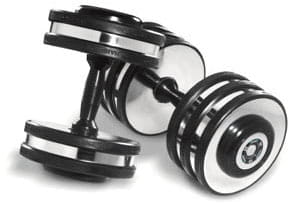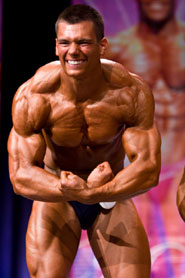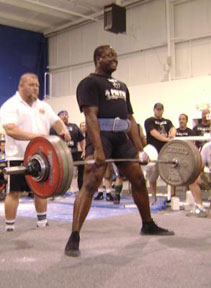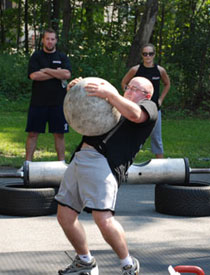If you've been looking for a different training technique to break out of a rut, eliminate the boredom, and bring on new results, workout "complexes" may be just what you've been looking for.
What are workout "complexes"?
If you've never heard of "complexes" before, the basic concept is that instead of repeating the same exercise for multiple reps to complete a "set", you sequence one rep of several different exercises right after one another and repeat the sequence several times to complete a "set". It's basically like performing a routine, instead of just mindlessly performing a typical "set".
same exercise for multiple reps to complete a "set", you sequence one rep of several different exercises right after one another and repeat the sequence several times to complete a "set". It's basically like performing a routine, instead of just mindlessly performing a typical "set".
This type of training is excellent to work a huge amount of your body's musculature in a short amount of time, and definitely takes your workouts to a whole new level of intensity. The conditioning aspect of this type of training is amazing, as you'll find yourself huffing and puffing after repeating a sequence a mere two or three times.
If I had to venture a guess, I'd have to say that this type of training probably elicits a good growth hormone response as well, due to the large amount of full body work completed in a given time period.
I like to incorporate about 5 exercises into my complexes. Any more than that and you might start to forget what's next in the sequence. I'm going to show you example routines to use for "complexes" below for barbells, dumbbells, and even kettlebells too. I'm willing to bet this is a totally different style than you've ever trained before.
Here's an example of a killer barbell complex that really gets me fired up:
Example Barbell "Complex" Sequence
- 1 rep: barbell clean and press from floor (explosive lift of barbell from floor to "catch" on front shoulders in one motion, then push-press overhead);
- 1 rep: barbell back to thighs, then hang clean (explosively pull bar from knees and "catch" the bar at shoulders);
- 1 rep: keep barbell at shoulders, then front squat;
Use a weight that you can still handle for your weakest lift of the bunch, but keep it heavy enough to challenge you. Try to repeat the sequence 2-3 times without resting… That's 1 set. You could progress over time on this routine by increasing the amount of times you repeat the sequence in each set, or by adding sets on subsequent workouts before eventually increasing the weight.
For example, say you completed the above complex with 155-lbs for 3 sequences per set for 3 sets in today's workout. Next time you perform the workout, try to do 155-lbs for 3 sequences per set for 4 sets. Once you successfully complete 5 sets with 155, increase the weight 5 or 10 lbs next time, and drop back to 3 sets. This is a great way to make improvements over time, while cycling your training volume.
Now I'm going to show you a great kettlebell complex that really kicks my butt. If you don't have a kettlebell, you can use a dumbbell, but I'd highly recommend picking yourself up a kettlebell… they're very convenient to have around the house when you want to bang out a quick intense workout at home without going to the gym.
I've been training with kettlebells for about 5 years now, and can definitely say that they've dramatically improved my strength and overall physical capabilities. If you're not familiar with kettlebells, they are an old eastern European training secret that has just started to take the US by storm over the last few years. Many elite athletes are using kettlebells as their preferred training tool for serious results. If you're new to kettlebells, you can learn how to get started with kettlebells at this article.
I'd recommend just starting off with one kettlebell and learn all of the single kettlebell drills first, before delving into the double-bell drills. Just one kettlebell coupled with some bodyweight exercises can literally be enough to comprise your own home gym, without any other equipment necessary. Or a kettlebell can just be a great alternative workout to incorporate into your routines once or twice a week. Either way, it opens up a whole new world of training for you.
Example Kettlebell Complex
- one arm swing
- one arm snatch, keep the bell over head;
- one arm overhead squat;
- bell back down to bottom, then one arm high pull;
- bell back down to bottom, then one arm clean & press
- repeat sequence with opposite arm
As with the barbell complex, repeat the sequence (without rest) 2-3 times with each arm. That's one set…and one hell of a killer set at that! Try increasing from 3 to 4 to 5 sets on subsequent workouts with a given weight before increasing your sequence reps. If you're not drenched in sweat with your heart beating out of your chest after that complex, you either went too light, or you are a mutant freak!
Since dumbbells are more accessible to most people than kettlebells, now I'll show you how to put together a good dumbbell complex. This dumbbell complex is a better option for beginners or intermediate exercisers. The barbell and kettlebell complexes I showed above are for advanced trainees.
Example Dumbbell Complex
- dumbbell squat and push-press
- front lunge with one leg, then the other
- back lunge with one leg, then the other
- curl to overhead press
- keep dumbbells at shoulders and squat
- repeat sequence 2-3 times
Again, the same type of sequencing and progressions explained with the barbell complexes work great with the dumbbell complexes. I think an amazing workout strategy is to alternate barbell complexes on one day with kettlebell or dumbbell complexes on alternative training days.
For example, you could do barbell complexes Monday, kettlebell or dumbbell complexes Wednesday, and back to barbell complexes on Friday. Maybe hit some sprints and bodyweight drills on Saturday; then Monday would be K-bell or D-bell complexes again, Wednesday would be barbells again, and so on. Give this program a try for a month (if you dare), and you will be one hardened individual! Make sure to shift to a different training style after 4-5 weeks as your body starts to plateau on this specific training routine.
If you want some more really unique training styles check out these great workouts called Max Workouts here.







